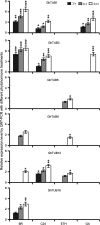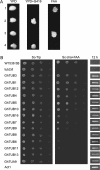Molecular cloning, expression profiling, and yeast complementation of 19 beta-tubulin cDNAs from developing cotton ovules
- PMID: 18596112
- PMCID: PMC2486464
- DOI: 10.1093/jxb/ern127
Molecular cloning, expression profiling, and yeast complementation of 19 beta-tubulin cDNAs from developing cotton ovules
Abstract
Microtubules are a major structural component of the cytoskeleton and participate in cell division, intracellular transport, and cell morphogenesis. In the present study, 795 cotton tubulin expressed sequence tags were analysed and 19 beta-tubulin genes (TUB) cloned from a cotton cDNA library. Among the group, 12 cotton TUBs (GhTUBs) are reported for the first time here. Transcription profiling revealed that nine GhTUBs were highly expressed in elongating fibre cells as compared with fuzzless-lintless mutant ovules. Treating cultured wild-type cotton ovules with exogenous phytohormones showed that individual genes can be induced by different agents. Gibberellin induced expression of GhTUB1 and GhTUB3, ethylene induced expression of GhTUB5, GhTUB9, and GhTUB12, brassinosteroids induced expression of GhTUB1, GhTUB3, GhTUB9, and GhTUB12, and lignoceric acid induced expression of GhTUB1, GhTUB3, and GhTUB12. When GhTUBs were transformed into the Saccharomyces cerevisiae inviable mutant, tub2, which is deficient in beta-tubulin, one ovule-specific and eight of nine fibre-preferential GhTUBs rescued this lethality. This study suggests that the proteins encoded by cotton GhTUBs are involved during cotton fibre development.
Keywords: Gossypium hirsutum (cotton) fibre; fuzzless-lintless mutant; phytohormone; β-tubulin.
Figures




Similar articles
-
Molecular characterization of the cotton GhTUB1 gene that is preferentially expressed in fiber.Plant Physiol. 2002 Oct;130(2):666-74. doi: 10.1104/pp.005538. Plant Physiol. 2002. PMID: 12376634 Free PMC article.
-
Functional genomics of fuzzless-lintless mutant of Gossypium hirsutum L. cv. MCU5 reveal key genes and pathways involved in cotton fibre initiation and elongation.BMC Genomics. 2012 Nov 14;13:624. doi: 10.1186/1471-2164-13-624. BMC Genomics. 2012. PMID: 23151214 Free PMC article.
-
A beta-tubulin-like cDNA expressed specifically in elongating cotton fibers induces longitudinal growth of fission yeast.Biochem Biophys Res Commun. 2002 Sep 6;296(5):1245-50. doi: 10.1016/s0006-291x(02)02069-7. Biochem Biophys Res Commun. 2002. PMID: 12207907
-
GbTCP, a cotton TCP transcription factor, confers fibre elongation and root hair development by a complex regulating system.J Exp Bot. 2012 Oct;63(17):6267-81. doi: 10.1093/jxb/ers278. J Exp Bot. 2012. PMID: 23105133 Free PMC article.
-
Gene expression changes and early events in cotton fibre development.Ann Bot. 2007 Dec;100(7):1391-401. doi: 10.1093/aob/mcm232. Epub 2007 Sep 27. Ann Bot. 2007. PMID: 17905721 Free PMC article. Review.
Cited by
-
Characterization and putative post-translational regulation of α- and β-tubulin gene families in Salix arbutifolia.Sci Rep. 2016 Jan 12;6:19258. doi: 10.1038/srep19258. Sci Rep. 2016. PMID: 26753794 Free PMC article.
-
Aberrant Expression of Critical Genes during Secondary Cell Wall Biogenesis in a Cotton Mutant, Ligon Lintless-1 (Li-1).Comp Funct Genomics. 2009;2009:659301. doi: 10.1155/2009/659301. Epub 2010 Jan 28. Comp Funct Genomics. 2009. PMID: 20148073 Free PMC article.
-
Flax tubulin and CesA superfamilies represent attractive and challenging targets for a variety of genome- and base-editing applications.Funct Integr Genomics. 2020 Jan;20(1):163-176. doi: 10.1007/s10142-019-00667-2. Epub 2019 Mar 2. Funct Integr Genomics. 2020. PMID: 30826923 Review.
-
Identification of TPX2 Gene Family in Upland Cotton and Its Functional Analysis in Cotton Fiber Development.Genes (Basel). 2019 Jul 4;10(7):508. doi: 10.3390/genes10070508. Genes (Basel). 2019. PMID: 31277527 Free PMC article.
-
Asymmetric subgenome selection and cis-regulatory divergence during cotton domestication.Nat Genet. 2017 Apr;49(4):579-587. doi: 10.1038/ng.3807. Epub 2017 Mar 6. Nat Genet. 2017. PMID: 28263319
References
-
- Anthony RG, Hussey PJ. Suppression of endogenous α and β tubulin synthesis in transgenic maize calli overexpressing α and β tubulins. The Plant Journal. 1998;16:297–304. - PubMed
-
- Arpat AB, Waugh M, Sullivan JP, Gonzales M, Frisch D, Main D, Wood T, Leslie A, Wing RA, Wilkins TA. Functional genomics of cell elongation in developing cotton fibers. Plant Molecular Biology. 2004;54:911–929. - PubMed
-
- Basra A, Malik CP. Development of the cotton fiber. International Review of Cytology. 1984;89:65–113.
-
- Bao Y, Kost B, Chua NH. Reduced expression of α-tubulin genes in Arabidopsis thaliana specifically affects root growth and morphology, root hair development and root gravitropism. The Plant Journal. 2001;28:145–157. - PubMed
Publication types
MeSH terms
Substances
LinkOut - more resources
Full Text Sources
Molecular Biology Databases

